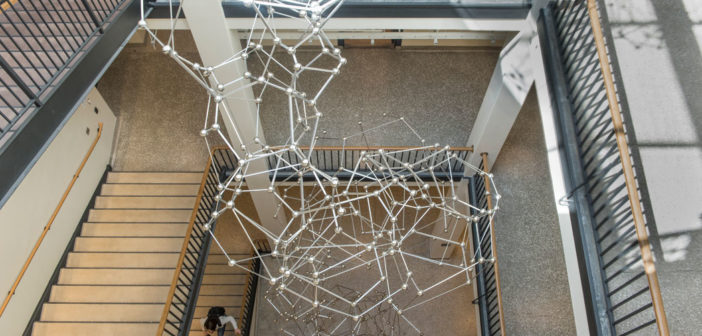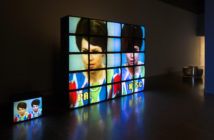Known for his work that confronts the fragile limits of perception and physicality, British sculptor Antony Gormley has confronted the human body throughout his career. In Chord (2015), a new public work permanently on view at MIT, Gormley challenges the idea of material and immaterial bodies. The sculpture is created through 1700 pounds of stainless steel forming thirty-three polyhedrons that extend from the ground floor to the glassed ceiling of MIT’s Maths and Sciences building, and in it, Gormley references both natural, abstract, and invisible formations.
I spoke with Gormley online after his trip to Boston to install Chord in the spring. Here, Gormley discusses his inspiration for Chord, its creation, and how he hopes the community will interact with the work. Gormley also considers the contribution of artists to the fabric of urban life; both individually and communally.
The sculpture was commissioned with MIT Percent-for-Art Funds. MIT’s Percent-for-Art program is administered by the MIT List Visual Arts Center.
I’ve read that Chord (2015) is a response to Brancusi’s Endless Column. Will you elaborate more on how your work responds to that of Brancusi? Brancusi began probing the ideas presented in Endless Column in the early twentieth century. How has Chord evolved these ideas for the twenty-first century?
With the Endless Column at Târgu Jiu in Romania, Brancusi may have been the first artist to make work in the twentieth century using industrial means. He applied the Taylorian principles of mass production to make repeating singular, identical cast iron units to reconsider the monumentality of an obelisk or a classical column, but nevertheless, make a connection between above and below. In many ways, this version of the Endless Column from 1938 contradicts the earlier handcrafted and carefully hand-finished versions carved in wood, many of which are still in his preserved studio at the Centre Pompidou in Paris. In this, his most public work, Brancusi reflected his time, the time of industrial production when the mechanical reproduction of multiples from a prototype overtook time spent on fabricating singular objects by hand. In many senses, Brancusi’s Endless Column of 1938 was the first ever serial work, and when Carl Andre brought the column down to the ground and made it into a place, he kept hold of Brancusi’s idea of the repeated, mechanically-produced unit. His work inspires me because of the way it sits between the organic and the modernist. Brancusi eschewed the grid and this is his only work that comes close to an absolute geometry. The way in which Brancusi turns the surface of his work into a reflecting mirror that plays its context back to the viewer is the result of his research into how form can interact with light.
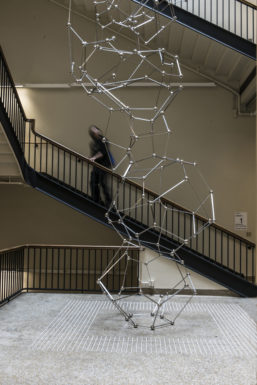
Antony Gormley, Chord (2015). Courtesy of the artist.
I have tried to retain this aspect of Brancusi’s work in Chord, but have replaced the mass production of a Fordist or Taylorian repetition with the stochastic, aleatoric nesting of completely independent polyhedral frames. I am interested in this chord being a column that reacts to light; in particular, to the changing light of the sky. Each of the 541 balls in the work reflects the world around it. Each element or section within the spiral matrix is only the size that it needs to be in order to do the work it has to do. Every element is active in Chord. The sculpture is live: it mediates between the upward thrust of a braced structure and the sprung tension of something held from above. Evidently, every element and every ball has its unique position within the whole, and every polyhedral frame has its own shape. To that extent, this is the absolute opposite of the compressive, serial construction that characterises Brancusi’s column, which uses the dead weight of a number of units threaded onto a vertical post. I think Chord represents a shift from Newtonian classical physics to the present state of understanding of matter, in which mass and energy dance and particles and waves can dip in and out of each other’s reality. The geometry of this work suggests that harmonics is not simply the result of known frequencies but is actually the independence of many variant frequencies that may be quite localised.
I’m interested in how you’ve constructed Chord. Will you talk about how the work is “nested and stacked” together? How does Chord relate to your other works with polyhedra?
The overall form of Chord is emergent rather than determined. It comes from an attempt to make a bubble matrix that allows a transfer of energy between nesting polyhedra. This form is the result of a long process of the evolution of the work; it was not pre-determined. We used specially made digital software at the studio which allows three-dimensional Voronoi cells to have differing degrees of internal pressure: this is what gives each cell its relational size as well as shape. This is how we created the original ‘foam’ from which the spiral helix was then isolated to make this work. At the end of the eighteenth century, Lord Kelvin asked what the most efficient way of structuring space might be. The bubble matrix is the answer. My ambition for Chord is that it should not occupy space but activate it. It implicates the space that it is inserted into, as the ground on which this materialised energy field acts.
You ask about its relationship to the other polyhedral works. Well, Chord is similar to Cloud Chain (2012), a work for the French National Archives and it relates to Drift (2009), the large work that I made for the Marina Bay Sands in Singapore. All of these works are attempts to make space itself the subject of a work. They refer to the body and the volumes that are created within the arc of the body, without illustrating it in any obvious way. They are an attempt to escape from the modernist grid and find a structure that is truly of our time. The Firmament works (2008–2010), like gothic cathedrals for the twenty-first century, are an attempt to make a structure that acknowledges the potential of mind to encompass space. As such they are meditative instruments.
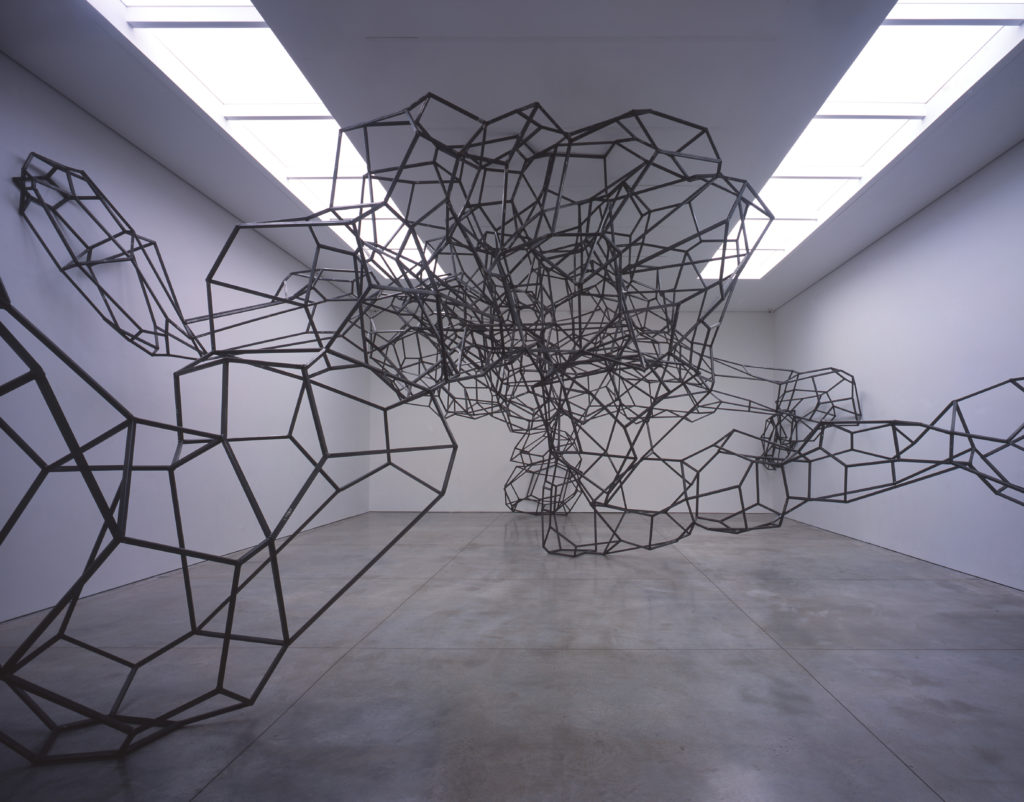
Antony Gormley, Firmament.
How do you research your work? How does this research affect the work?
Early on in my research, we were using Voronoi point seeding within a given space–either a bounding condition based on a body scan or a room. More recently, I have been researching how to make an open work that escapes the grid, and as a consequence became interested in both crystal and bubble foam matrices.
I am not doing this work alone; the engineer Tristan Simmonds helped to develop new software that we adapted to Rhino: a tool which enabled us to manipulate the vertices and tiles of the polyhedra to make Chord.
All of the work is research. Sculpture is a form of thinking physically, and we also need the tools to think, to predict and to model. The ability to test out the strengths and weaknesses of an emergent structure; to be able to allow something to dance around its centre of gravity–which is very much the case with Chord–are all exciting evidence of research and making. In other words, finding out what works in a more informed way than simply by trial and error.
Chord is placed very visibly within the building where MIT’s math and chemistry departments are located. How do you hope the students and professors of these departments interact with this piece, both physically and mentally? How would you like the greater MIT and Boston communities to interact with Chord?
I have no expectations of a particular kind of reaction. I just hope that the sculpture might energise the stairway, and make the journey up and down it more reflexive. First of all, it is the body that I want to engage and then, hopefully, the mind. I am fascinated that the sculpture is making the same journey from floor to sky as the bodies of the staff and students. There is the possibility that there is a kind of choreography between an object catching and playing with the light of the sky, and between human bodies that are subject to different kinds of weight, mass and velocity. Obviously, mathematical systems are materialised here. We are dealing with three element conjunctions on the surface and four element, tetrahedral nodes in the conjoined tiles of these 33 polyhedra. They are an example of an absolute system where, in spite of very consistent geometries in the nodes, we can have polyhedra of four or multiple-sided forms: absolute and random. I hope that the mathematicians will engage with the physical problem that Chord sets – or they could equally be fascinated by the frequencies of movement that it exhibits.
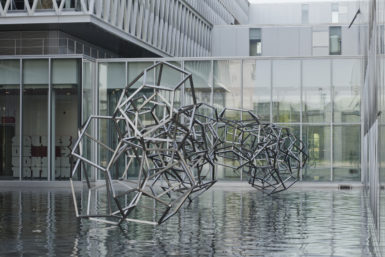
Antony Gormley, Cloud Chain. Courtesy of the artist.
I am very happy that it is now part of MIT, an organisation at the forefront of discovering new forms and materials, finding out ways of using them imaginatively. I hope that Chord has found a place where it can resonate with the spirit of this wonderful community of intelligent seekers, and that the wider community of MIT and Boston takes care of the work.
Lastly, in reference to London, you commented in the Brooklyn Rail that “in order for a city to retain vitality, it’s got to be able to carry and welcome young, creative people, and allow them to live in the texture of the inner city.” Boston artists are currently experiencing issues of gentrification and over-development; housing and space are extremely limited. What would you recommend that Boston and other cities do to ensure space for young artists and creatives?
Developers have used artists to revitalise areas of cities that have become redundant due to changing patterns of employment, or urban degradation and poverty, for the last 70 years. I think that the model that has been followed in London, from Soho to Shoreditch–where artists go in, make a community and then get pushed out as the developers come in–has got to change. I was lucky enough to be able to squat my first two studios in London and they were right in the centre. I am worried by what has happened to New York: Brooklyn and New Jersey have become the places where creative communities live–they are no longer part of the texture of Manhattan. I suggest that just as there is an incentive for the creation of affordable housing, there should be very strong planning encouragement for studio and work spaces for all forms of creative and artisan labour.
We have seen vast acreage of square footage given over to housing, with no understanding of the necessity of texture–how these spaces relate to the street, how street life can be made rich and engaged, and how the social body can be expressed through architectural means and collective spaces. We need to recognise that artists are part of a very necessary diversity–bankers should not be the only ones to occupy the heartlands of our cities. I appeal to all developers to keep artists as part of the texture of our shared lives.
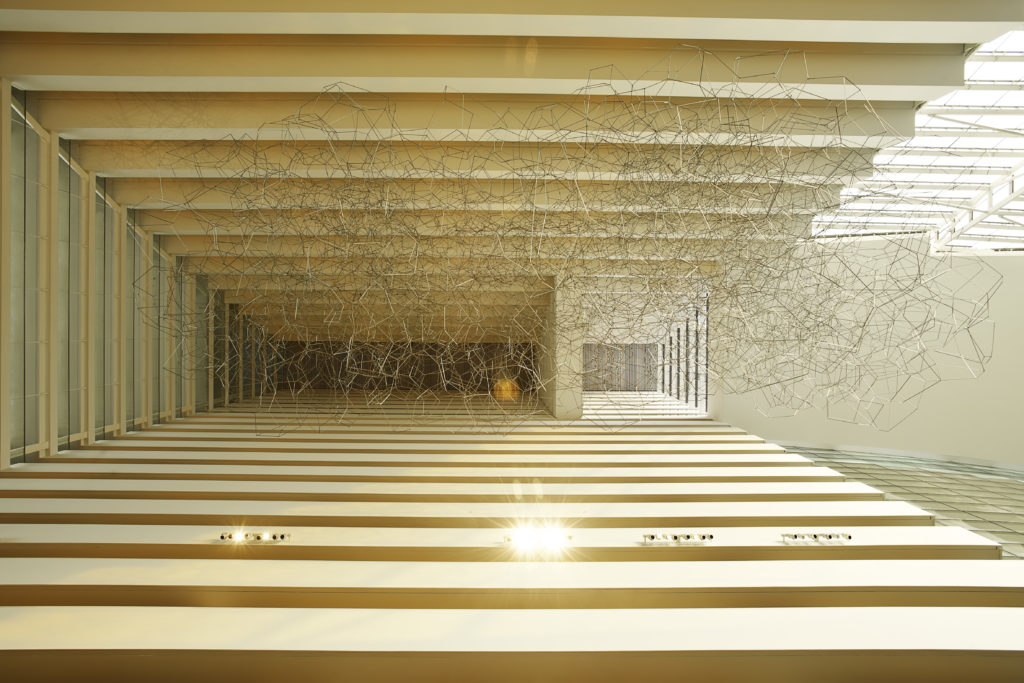
Antony Gormley, Drift. Courtesy of the artist.

